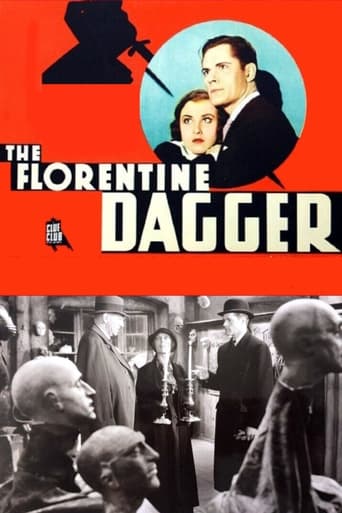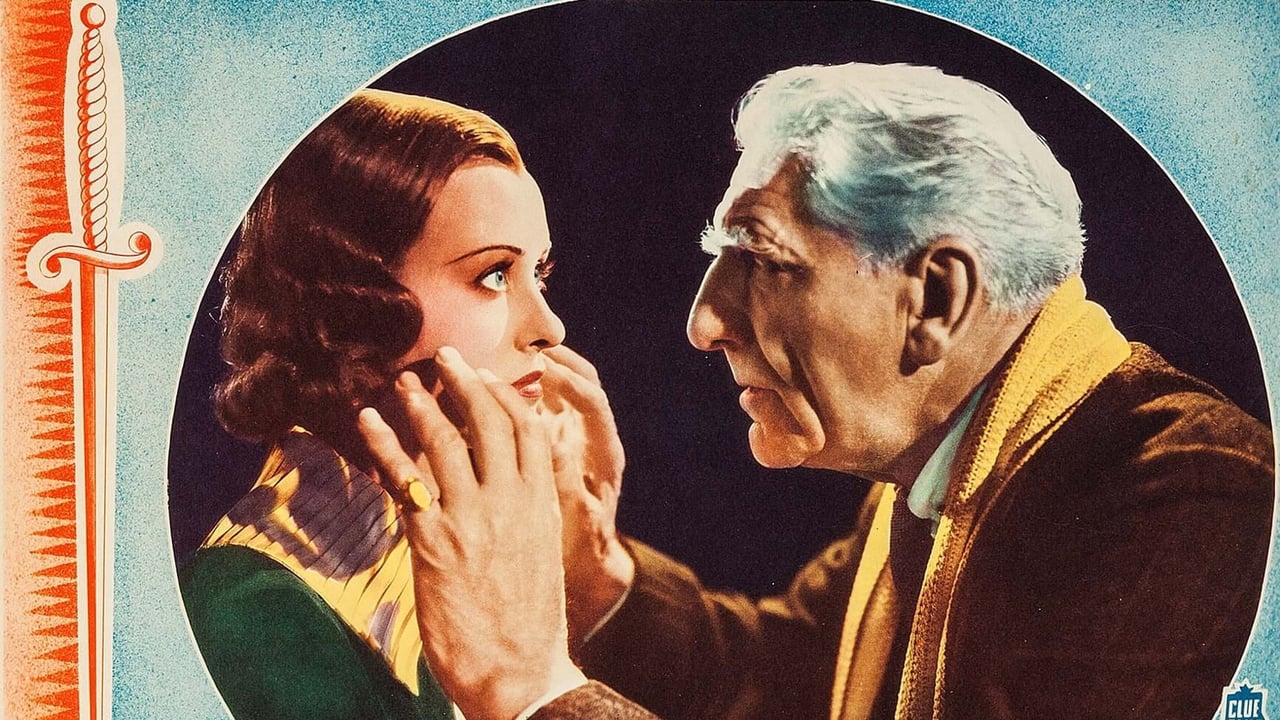JohnHowardReid
Copyright 1 April 1935 by Warner Bros Pictures, Inc. A Crime Club Picture, presented by Warner Bros Pictures and The Vitaphone Corp. New York opening at the Mayfair: 26 April 1935. Australian release: 8 May 1935. 7 reels. 70 minutes.SYNOPSIS: Who murdered impresario Victor Ballau? His daughter, currently playing Lucrezia Borgia in a play written by a direct descendant of Cesare Borgia (who is himself under treatment for possible schizophrenia)? A psychiatrist who is subject to sudden, unexplained mood changes? A grim, beaten servant, mousily unobtrusive, who admits she was alone in the house with the victim when the murder was committed? A cat-and-mouse police captain who seems too knowingly off-hand? Or a crazy-looking old woman who successfully bids for the murder candlesticks at an auction of the victim's effects? COMMENT: Hecht's novel deals with three sets of dual personalities which are carried over into this moodily atmospheric film version in such a clever manner that we are really never quite sure of the genuineness or sanity of any of the principal characters.In the best performance of his career, Donald Woods, normally a rather wooden and stodgy actor, not only provides an able and ingratiating study but gives his portrait a neurotic intensity that makes it doubly fascinating. Margaret Lindsay too infuses her characterization with a depth and an edge that makes it seem for a time as if the script is about to duplicate "A Double Life". And as for C. Aubrey Smith, how wonderful it is to see this fine actor filling a role worthy and large enough for his brilliant talents. Henry O'Neill excels too, whilst it's great to find Robert Barrat limning an unusual role in a most entertaining balance of comic/dramatic perfection. Florence Fair made only ten or so sound films, all around this period. If this is a fair sample of her extraordinary histrionic gifts, we are certainly looking forward to seeing her again. In addition to drawing these magnificent performances, director Robert Florey has infused the whole film with a beguilingly brooding atmosphere — assisted by some wonderful sets from Grot and Weyl, plus Todd's superlative lighting and camera-work. The script rivets the attention throughout. The sarcastic and dallying dialogue provided to and so expertly delivered by Robert Barrat offers a neat contrast to the Gothic trappings of a fascinating plot.ANOTHER REVIEW: Three suspects in the novel, but each has a dual personality. In solving the mystery, it's a question not only who benefits but which of the schizos did the deed. In translating this to the screen, the writers have made a large number of equally ingenious changes. Florey's direction is most competent. The set designers have wrought wonders. - JHR writing as George Addison.
briantaves
Although technically made after more stringent censorship resumed, THE FLORENTINE DAGGER (1935) violates the expectations of both formula and the censorship of the time. The movie was the result of a hasty production that did not augur well for it. Director Robert Florey was designated to helm the project only a week before shooting began. Tom Reed's script was still being rewritten and substantially changed during photography, with the entire ending changed. Star Donald Woods was considered too inexperienced for the lead, and on the first day of shooting he became so nervous that he lost his voice. The movie was shot in a mere 20 days, on a $135,000 budget. Nonetheless, for Warner Bros., in 1935, this did not make THE FLORENTINE DAGGER, properly speaking, a "B," but instead it was intended as an unusual, high-quality item. 1. Writer Reed and director Florey had already collaborated in similar capacities on MURDERS IN THE RUE MORGUE (Universal, 1932). THE FLORENTINE DAGGER added themes not present in the Ben Hecht novel but which deepened it considerably. Using a "pre-noir" style, the consistently strange, unnatural behavior of each of the performers is augmented by Florey's expressionistic treatment, with painterly camera-work by Arthur Todd, full of oblique angles, dark lighting, shadow effects, and composition in depth, heightening moments of drama and character revelation. Many objets d'art from director Florey's own collection enrich the set design and enhance the chilling mood it creates. In a move seldom allowed contract directors, Warner Bros. permitted Florey to oversee the editing, so that pace, choice of shots, and narrative all combine together to memorably explore the psyche of its characters.Operating on multiple levels, THE FLORENTINE DAGGER delves past a surface mystery into a domain where the apparently dead past intrudes on the present, releasing ungovernable passions. Woods plays a modern descendant of the Borgias, Cesare, driven to the brink of suicide by his belief that he has a dual personality, with his subconscious half inheriting the murderous proclivities of his ancestors. A misogynist psychiatrist, Dr. Lytton (C. Aubrey Smith) suggests Cesare exorcise his internal demons by writing a play on the Borgias, but no sooner has he done so, and been supposedly cured of his obsession, than events shed doubt on the viability of such a cure. Cesare falls in love with leading lady Florence Ballau (Margaret Lindsay), but it appears she is becoming her role--Lucretia Borgia. Florence is accused of murdering her father, theatrical producer Victor Ballau, but in investigating on her behalf, Cesare uncovers a maelstrom of revenge and bitterness stretching back over two decades. While Cesare's fear is the product of his own delusion, others are experiencing deep and far more real psychological turmoil. Victor, at first the apparent victim of a crime, turns out to be far more depraved than even Cesare could imagine. Victor was, in fact, Florence's stepfather, who tried to kill her mother, stage star Teresa (Florence Fair), by setting her dress afire. She survived, hiding her now hideously scarred visage behind a naturalistic mask and impersonating a servant to be with Florence. Not until Victor begins to nearly-incestuously force himself on stepdaughter Florence, having fallen perversely in love with her and jealously attempting to destroy her romance with Cesare, does Teresa finally take vengeance against the patriarchal power that has nearly destroyed the lives of two women. Overhearing Teresa's confession to Cesare, psychiatrist Lytton realizes his theories of patricide have been entirely wrong, and the police inspector in charge of the case allows Teresa, Florence, and Cesare, to escape together--without the compensatory suicide of Teresa called for by the original script and Hays Office policy. Only by assuming that the Hays Office was paying little attention to a modestly-budgeted thriller, whose conclusion was changed in production, can we explain how a film so obviously in violation of the tenets of the code was allowed. Somehow, this film was released, without much recognition by critics of just how unusual it was. Today, The Florentine Dagger can be recognized as one of the truly subversive films of its era, and one whose content would not be accepted in films until at least forty years later, making it decades ahead of its time.
Ron Oliver
A young Italian, the last of the Borgias, fears he is cursed with the evil of his infamous family. And now the woman he loves may be guilty of a nasty murder...Based on a novel by Ben Hecht, THE FLORENTINE DAGGER is raised above the level of modest murder programmers on the strength of its unusual plot, moody atmospherics and very fine acting. Sir C. Aubrey Smith graces the proceedings as a kindly old doctor who helps a young playwright and a spirited actress (Donald Woods & Margaret Lindsay) find happiness together, despite homicide and a possible family curse. Robert Barrat is also much fun as an eccentric, flirtatious police inspector; surprisingly, he becomes the story's true hero in the movie's closing moments.The supporting cast includes Henry O'Neill as a Viennese theatrical producer; Florence Fair as his troubled housekeeper; Frank Reicher as a harried stage manager; Rafaela Ottiano & Charles Judels as worried Italian innkeepers; Paul Porcasi as a timid policeman; Eily Malyon as a lady who knows more about the murder than she's willing to say; and wonderful Herman Bing as a flustered Austrian baker.The conclusion comes as a bit of a surprise, considering the Production Code's requirement for the punishment of all movie murderers...*************************Much is said, in the film's first half, about Cesare Borgia. It might prove interesting to review the facts of his life. The illegitimate son of Pope Alexander VI, Cesare (1475-1507) started his rise to power early, first in his ancestral Spain and later in Italy. At the age of seven he was created prothonotary & canon of the cathedral of Valencia - but it was in 1491 at the age of sixteen that his career really started to move. Over the course of the next two years Cesare was quickly created bishop, archbishop & cardinal. In 1498 he renounced his cardinalate to become Captain General of the Papal Army. Working hand in glove with the Pope, his father, they furthered their schemes towards wresting a northern Italian kingdom for Cesare.A marriage that same year with the sister of the King of Navarre and the acceptance of a French dukedom, gave Cesare & Alexander the French support they would need for their plots of conquest. By 1500 Cesare was fully immersed in his generally successful campaigns. (One of his victims was Duke Alfonso of Bisceglie, the husband of Cesare's wicked sister Lucrezia; that unlucky gentleman had been stabbed by a quartet of Cesare's assassins and subsequently strangled in his sickbed by Cesare's servant.) Hated & despised by the rank and file of the citizenry of Italy, Alexander & Cesare had to constantly fight against the overwhelming tide of public opinion.Surviving one rebellion in his army - and treacherously murdering the ringleaders after feigning peace - Cesare's fortunes at last crumbled with the death of his father in 1503. The new pope, Julius II, was an implacable enemy and demanded the release of Cesare's dominions. Cesare was eventually captured by the Spanish, imprisoned in Spain, and made a daring escape. He now offered his services to his brother-in-law, the King of Navarre. Cesare Borgia's short, violent, utterly fascinating life came to an end in 1507 when he was killed in a skirmish with rebels.
bmacv
This 65-minute mystery was part of the Warner Brothers' "Clue Club" series of programmers. Most of these short thrillers are truly unwatchable melanges of slapstick and skullduggery. The Florentine Dagger is a little better, and does keep one's interest with the foggy Viennese (as opposed to foggy London) locations, production values that aren't bottom-of-the-barrel, and a story that involves a descendant of the Borgias. C. Aubrey Smith lends a real whiff of greasepaint to the proceedings. Don't waste your life waiting for this one to roll around, but, if you catch it, you may find it a tolerable way to pass an hour.


 AD
AD



